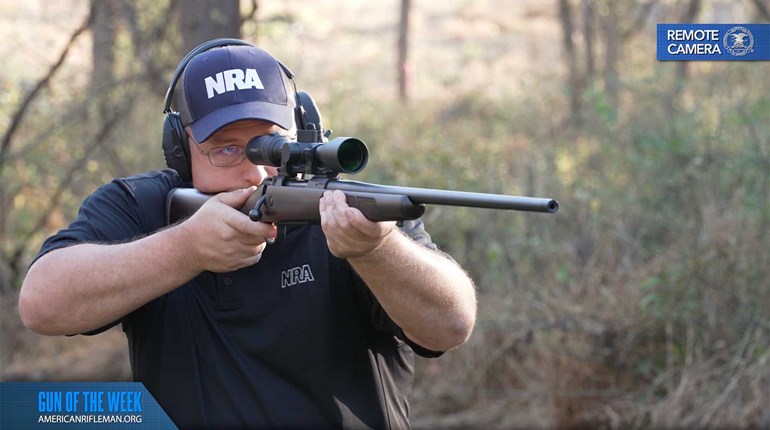
Perhaps the single most noticeable change in firearms over the last 15 to 20 years has been the proliferation of synthetic stocks. Whether we’re talking rifles, shotguns or muzzleloaders, synthetic stocks are all the rage, and while I don’t have the hard data to support my claim, I would suggest that synthetic stocks are now far outdistancing wood-stocked firearms in new gun sales. But are they a superior product? The answer is yes, and no.
Synthetic stocks first hit the market in the mid-1960s when Chet Brown of Brown Precision introduced a fiberglass stock to the sporting fraternity, having first won over the very particular bench-rest crowd. Bench shooters appreciated the consistency that glass stocks afforded, as they never swell or shrink as wood does, which can put pressure on the action or barrel, ultimately effecting a rifle’s accuracy.
What started as a fad became a movement by the early 1980s when Weatherby introduced the Fibermark—the first synthetic-stocked factory rifle. Since then, all of the major manufacturers have jumped on board, and synthetics have evolved from pure, hand-laid fiberglass to today’s mixtures of Kevlar, graphite, boron, fiberglass, urethane and plastics, some hand-laid, others injection-moulded.

There’s simply no denying that synthetic stocks are considerably more moisture-resistant than traditional wood stocks. They’re physically incapable of absorbing water, making them impervious to the swelling and shrinking that even the finest wood stock will suffer if subjected long enough to moisture.
Synthetic stocks are also inherently stronger than wood stocks. I’ve fallen more than a few times with synthetic-stocked rifles, and other than some chips and scrapes, the stocks have all come through unscathed. The same can’t always be said for wood stocks, which are far more prone to cracking or breaking, and I’ve had the unfortunate experience to back up that assertion.
There’s a common notion that synthetic stocks are lighter than wood, but this isn’t always true. Depending on whether they’re solid or hollow, along with how they’re designed, synthetic stocks can weigh as much, or more in some cases, than wooden stocks. While most of today’s ultra-light rifles are synthetic-stocked, it’s really the reduction in the amount of metal, or the type of metal used, that contributes most to the reduced weight.
Are synthetic-stocked rifles inherently more accurate than those stocked in wood? Absolutely not. The stock material has no bearing on whether a rifle shoots well; raw accuracy depends on barrel quality, bedding quality and a host of other variables. It is true, however, that a synthetic stock rifle is less likely to change its point of impact in extreme weather.
It’s also probably fair to say that, on average, synthetic-stocked firearms are less expensive than wooden-stocked rifles, and this price gap is likely to widen as technology improves and stock-quality walnut becomes scarcer. But, the comparisons shouldn’t end there.
My two primary deer rifles have synthetic stocks—my 7mm Rem. Mag. features a McMillan stock, and my .25-06 has a Brown Precision stock. Both rifles are reliable and shoot consistently well when I hold up my end of the bargain. About three years ago, however, I got the itch for another gun—a semi-custom rig that would be my dream rifle. When it came time to decide on the stock, I didn’t think twice before selecting a beautiful piece of walnut.

There’s just something about the warmth, feel and look of a wooden stock that synthetics will never be able to replicate, and if this was to be my only rifle of truly hand-me-down quality, there was no question it had to feature wood. And by the way, it shoots as good as it looks.
Much like rifles, shotguns also offer the shooter plenty of choice between synthetic and wooden stocks. I typically shoot wooden-stocked guns when upland hunting or field hunting for ducks and geese. But when I head out on the big water after diving ducks, where everything invariably gets soaking wet and banged around, I pull my synthetic-stocked Beretta off the rack.
For many hunters, firearms are more than mere tools of the trade—they’re a meaningful, if difficult to articulate, link between the hunter and the hunting experience that goes well beyond the simple mechanics of shooting. For some, wood stocks will always be the choice when practicality allows. But for others, firearms are there to do a job, period, and I suspect those hunters will increasingly select synthetic stocks.
As for me, when hunting in extreme weather, I’ll select a rifle or shotgun that sports a synthetic stock. When conditions allow, however, most often I’ll reach for a firearm dressed in walnut.



































